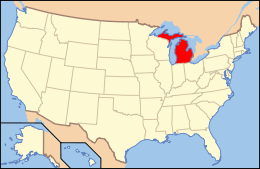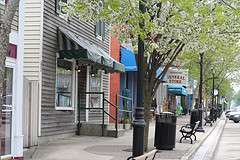Sanilac County, Michigan
| Sanilac County, Michigan | ||
|---|---|---|
| ||
 Location in the U.S. state of Michigan | ||
 Michigan's location in the U.S. | ||
| Founded |
September 10, 1822 (created) 1848 (organized)[1] | |
| Seat | Sandusky | |
| Largest city | Sandusky | |
| Area | ||
| • Total | 1,590 sq mi (4,118 km2) | |
| • Land | 963 sq mi (2,494 km2) | |
| • Water | 627 sq mi (1,624 km2), 39% | |
| Population | ||
| • (2010) | 43,114 | |
| • Density | 45/sq mi (17/km²) | |
| Congressional district | 10th | |
| Time zone | Eastern: UTC-5/-4 | |
| Website |
www | |
Sanilac County is a county located in the U.S. state of Michigan. As of the 2010 census, the population was 43,114.[2] The county seat is Sandusky.[1][3] The county, which is part of the Thumb region, was created on September 10, 1822, and was fully organized in 1848.[1]
Sanilac County is considered to be part of the Thumb of Michigan, which in turn is a subregion of the Flint/Tri-Cities. Sanilac County enjoys seasonal tourism in towns such as Lexington, Port Sanilac, and Carsonville. Sanilac County is economically attached to St. Clair County and Huron County and has very fertile, flat land.
History

Sanilac County was probably named for a Wyandot (Huron) chief named Sanilac.[4] (See List of Michigan county name etymologies). The county was formed on September 10, 1822, by Michigan Territory from part of St. Clair County and unorganized territory administered by Oakland County. It lost land to the creation of Huron and Tuscola counties in 1840. The county government was fully organized on December 31, 1849.[5]
In the middle of the 19th century, the area now called Port Sanilac was called Bark Shanty. It was named for a lone shanty made of bark, which was used to make shingles from pine. The Algonquin word "zngwak" means pine. The county seat of Sanilac is the city of Sandusky.
Geography
According to the U.S. Census Bureau, the county has a total area of 1,590 square miles (4,100 km2), of which 963 square miles (2,490 km2) is land and 627 square miles (1,620 km2) (39%) is water.[6]
Adjacent counties
- Huron County (north)
- Tuscola County (west)
- St. Clair County (south)
- Lapeer County (southwest)
- Huron County, Ontario, Canada (east)
Major highways
Demographics
| Historical population | |||
|---|---|---|---|
| Census | Pop. | %± | |
| 1850 | 2,112 | — | |
| 1860 | 7,599 | 259.8% | |
| 1870 | 14,562 | 91.6% | |
| 1880 | 26,341 | 80.9% | |
| 1890 | 32,589 | 23.7% | |
| 1900 | 35,055 | 7.6% | |
| 1910 | 33,930 | −3.2% | |
| 1920 | 31,237 | −7.9% | |
| 1930 | 27,751 | −11.2% | |
| 1940 | 30,114 | 8.5% | |
| 1950 | 30,837 | 2.4% | |
| 1960 | 32,314 | 4.8% | |
| 1970 | 34,889 | 8.0% | |
| 1980 | 40,789 | 16.9% | |
| 1990 | 39,928 | −2.1% | |
| 2000 | 44,547 | 11.6% | |
| 2010 | 43,114 | −3.2% | |
| Est. 2015 | 41,475 | [7] | −3.8% |
| U.S. Decennial Census[8] 1790-1960[9] 1900-1990[10] 1990-2000[11] 2010-2013[2] | |||

The 2010 United States Census[12] indicates Sanilac County had a 2010 population of 43,114. This is a decrease of -1,433 people from the 2000 United States Census. Overall, the county had a -3.2% growth rate during this ten-year period. In 2010 there were 17,132 households and 11,885 families in the county. The population density was 44.8 per square mile (17.3 square kilometers). There were 22,725 housing units at an average density of 23.6 per square mile (9.1 square kilometers). 96.6% of the population were White, 0.5% Native American, 0.3% Black or African American, 0.3% Asian, 1.1% of some other race and 1.2% of two or more races. 3.3% were Hispanic or Latino (of any race). 26.1% were of German, 11.0% Polish, 10.4% English, 8.3% Irish, 7.2% American and 5.1% French, French Canadian or Cajun ancestry.[13]
There were 17,132 households out of which 29.2% had children under the age of 18 living with them, 55.3% were husband and wife families, 9.8% had a female householder with no husband present, 30.6% were non-families, and 26.4% were made up of individuals. The average household size was 2.48 and the average family size was 2.97.
In the county the population was spread out with 23.6% under age of 18, 7.4% from 18 to 24, 21.8% from 25 to 44, 29.6% from 45 to 64, and 17.6% who were 65 years of age or older. The median age was 43 years. For every 100 females there were 97.8 males. For every 100 females age 18 and over, there were 96.7 males.
The 2010 American Community Survey 3-year estimate[12] indicates the median income for a household in the county was $39,138 and the median income for a family was $47,885. Males had a median income of $27,440 versus $16,509 for females. The per capita income for the county was $19,671. About 1.5% of families and 16.1% of the population were below the poverty line, including 23.3% of those under the age 18 and 11.4% of those age 65 or over.
Religion
The Roman Catholic Diocese of Saginaw is the controlling regional body for the Catholic Church.[14]
Government
The county government operates the jail, maintains rural roads, operates the major local courts, keeps files of deeds and mortgages, maintains vital records, administers public health regulations, and participates with the state in the provision of welfare and other social services. The county board of commissioners controls the budget but has only limited authority to make laws or ordinances. In Michigan, most local government functions — police and fire, building and zoning, tax assessment, street maintenance, etc. — are the responsibility of individual cities and townships.
The county has voted for the Republican nominee in every presidential election since the GOP's inaugural election in 1856, except in 1912, when the county supported Theodore Roosevelt's Bull Moose Party campaign. However, they had voted for the Republican nominee in 1912, William Howard Taft in the previous election. Hence, every person who has won the GOP's nomination has won Sanilac County, Michigan.
Elected officials
- Prosecuting Attorney: James V. Young
- Sheriff: Garry Biniecki
- County Clerk: Linda Kozfkay
- County Treasurer: Kathy Dorman
- Register of Deeds: Michele VanNorman
- Drain Commissioner: Gregory L Alexander
- Circuit Court Judge: Hon. Donald A. Teeple
- Probate Court Judge: Hon. Gregory S. Ross
- District Court Judge: Hon. Gregory S Ross
- County Commissioners: Daniel Dean, Justin Faber, John Hoffmann, James Ruby, Donald A. Hunt
Media
Sanilac/GB Broadcasting operates three radio stations in Sanilac County. The county is served weekly by the Tribune-Recorder since 1893, the Sanilac County News of Sandusky and other small newspapers. Also daily deliveries of the Port Huron Times Herald are available in Sanilac County.
Communities
Cities
- Brown City
- Croswell
- Marlette
- Sandusky (county seat)
Villages
Townships
- Argyle Township
- Austin Township
- Bridgehampton Township
- Buel Township
- Custer Township
- Delaware Township
- Elk Township
- Elmer Township
- Evergreen Township
- Flynn Township
- Forester Township
- Fremont Township
- Greenleaf Township
- Lamotte Township
- Lexington Township
- Maple Valley Township
- Marion Township
- Marlette Township
- Minden Township
- Moore Township
- Sanilac Township
- Speaker Township
- Washington Township
- Watertown Township
- Wheatland Township
- Worth Township
Unincorporated communities
See also
- List of Michigan State Historic Sites in Sanilac County, Michigan
- National Register of Historic Places listings in Sanilac County, Michigan
References
- 1 2 3 "Bibliography on Sanilac County". Clarke Historical Library, Central Michigan University. Retrieved January 29, 2013.
- 1 2 "State & County QuickFacts". United States Census Bureau. Retrieved August 29, 2013.
- ↑ "Find a County". National Association of Counties. Retrieved 2011-06-07.
- ↑ Michigan government on origin of county names
- ↑ John H. Long, Editor; Peggy Tuck Sinko, Associate Editor and Historical Compiler; Douglas Knox, Book Digitizing Director; Emily Kelley, Research Associate; Laura Rico-Beck, GIS Specialist and Digital Compiler; Peter Siczewicz, ArcIMS Interactive Map Designer; Robert Will, Cartographic Assistant (2007). "Michigan: Individual County Chronologies". Atlas of Historical County Boundaries. Newberry Library.
- ↑ "2010 Census Gazetteer Files". United States Census Bureau. August 22, 2012. Retrieved September 28, 2014.
- ↑ "County Totals Dataset: Population, Population Change and Estimated Components of Population Change: April 1, 2010 to July 1, 2015". Retrieved July 2, 2016.
- ↑ "U.S. Decennial Census". United States Census Bureau. Retrieved September 28, 2014.
- ↑ "Historical Census Browser". University of Virginia Library. Retrieved September 28, 2014.
- ↑ "Population of Counties by Decennial Census: 1900 to 1990". United States Census Bureau. Retrieved September 28, 2014.
- ↑ "Census 2000 PHC-T-4. Ranking Tables for Counties: 1990 and 2000" (PDF). United States Census Bureau. Retrieved September 28, 2014.
- 1 2 "American Factfinder". United States Census Bureau. Retrieved March 11, 2012.
- ↑ Data Access and Dissemination Systems (DADS). "American FactFinder". census.gov.
- ↑ "Diocese of Saginaw". saginaw.org.
Further reading
- "Bibliography on Sanilac County". Clarke Historical Library, Central Michigan University. Retrieved January 29, 2013.
External links
 |
Huron County |  | ||
| Tuscola County | |
Lake Huron | ||
| ||||
| | ||||
| Lapeer County | St. Clair County |
Coordinates: 43°28′N 82°38′W / 43.46°N 82.64°W
